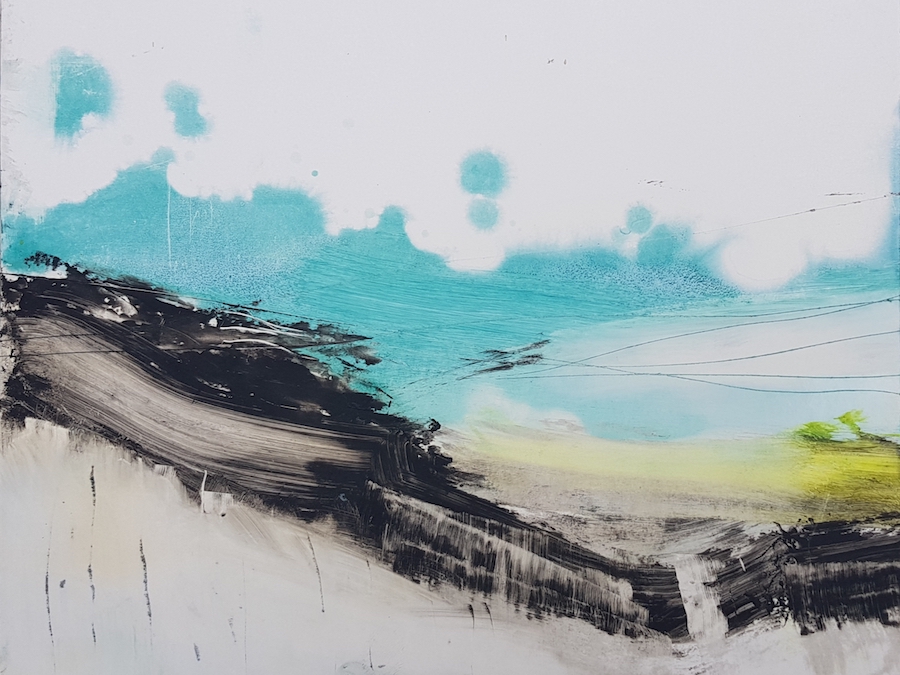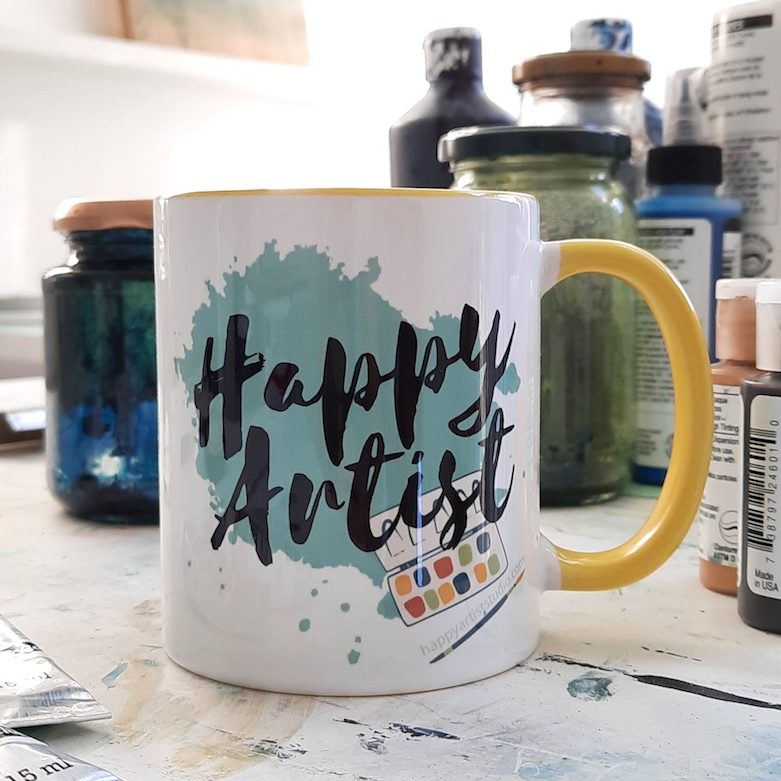
Recently I received a message on Instagram from @ruthwaldronart, asking a version of this question.
It’s one I’ve asked myself many times, and have often heard others ask.
I’ve come to some conclusions about the answer for myself, and thought it might be helpful to share in case it’s something that bothers you too.
Here’s what Ruth said:
“I’m doing a lot of art on paper at the moment and it’s done pretty fast. I kinda get one chance at the image which is fine but I’m struggling with the idea that many layers and ‘not falling in love early’ is the best way to make art… I get that, but I’m confused.
What do you think about doing fast pieces with only one or two layers?”
Have you ever wondered about this?
Is it still art if it happened really quickly? Is it valid? Is it cheating somehow? Can it still be considered strong work?
If you’ve ever wondered or worried about it, you’re not alone!
I’ve definitely struggled with this myself over the years, particularly as my work has always been relatively quick to come together.
I’m not generally the kind of artist who works on a single painting for weeks or months; although some paintings do take a long time to complete, that’s not because I’m working on them every day, adding more paint. And many of my paintings have been completed quickly so this is a question I’ve had to address for myself.
Here are my thoughts at this point on the journey:
Some paintings just do happen very quickly, and it can feel hard to accept that they’re ‘valid’ as completed work if there wasn’t any struggle or very much time involved.
But then think about the months and years of work – the 10,000 hours – that have built up behind that painting, that made it possible for it to manifest very quickly.
It’s like when you spend three days at a workshop and then make something a whole level up on the last day in just a few minutes; those three days were the groundwork for that final piece. I’ve done this more than once.
Here’s a case in point – three days of ups and downs, and then suddenly, this one flew out. In spite of the shocking photo, this one felt qualitatively different from the others, and it sold almost immediately.

This one was pretty speedy and has sold too:

Work that comes out quickly can connect just as deeply with the viewer as work that took months to complete. Annoying, perhaps, but true.
Although…
The only time I’d say this doesn’t apply quite so much is for beginners. Yes, a beginner/early stage artist could make something really strong very quickly, but it’s less likely that that would be a frequent occurrence, because the depth of experience and understanding isn’t there yet.
There’s just no getting around the fact that mastery comes from long experience; from trying and being disappointed and keeping going no matter what.
With my current paintings this applies even more as I don’t do the many layers I used to, which was a much more forgiving way to make art for obvious reasons.
Now I have to ‘get it right’ pretty much immediately, and I couldn’t do that – I simply wouldn’t have the understanding – if I hadn’t already done all those years of mixed media layering and experimenting.
{And making tons of very weak paintings!} I should also add that not all of them work by any means!
Below are three that I think work well – two of which have sold – and between you and me, didn’t take that long in terms of applying paint to surface.
{As a caveat, there are – of course – quite a few boards that aren’t working and are taking much longer to evolve.}

For some artists, a painting requires many carefully applied or reworked layers to work, and because of this, and perhaps myths and assumptions about what a ‘real’ artist does – and how – it seems easy to forget that there are as many ways to make art as there are artists.
Your process is as unique as you are.
There are tons of artists whose work is about spontaneity and a more minimal approach. Chinese brush painting is a great example of this. You literally have one chance to get each brush stroke right; it’s incredibly hard but the result often looks deceptively simple!
I think the more you come to ‘own’ your work, the easier it becomes to recognise that work can be strong and quick.
What do you think about this? Do you make ‘quick art’? If so, have these questions of validity come up for you? Share your thoughts and experiences in the comments!







Hi, your sign-up form won’t accept my very normal email address.
Sorry to hear that Avril. I’ve added you manually. 🙂
Great post! And I agree. You are going to put in the time, whether on one piece or all the paintings, studies, etc. that came before. So a work that is executed quickly actually has all of those prior hours of work behind it.
Exactly! It’s all cumulative; it’s not like you’re reinventing the wheel with every painting!
I agree absolutely, be grateful for those that do come out successfully and feel right in a short time!
Yes, it’s really just a mindset shift when it comes down to it isn’t it! Gratitude rather than doubt/guilt. 😉
I’ll just say: Tina Berning. Her work on paper doesn’t take more than some minutes to do. Is it not amazing art for that?
My own artistic experience confirms what you’re saying. The works that have just come about effortlessly och quickly usually make me more satisfied (and sell best).
But I have to point out that this theory many applies best if you’re more on the abstract side of the scale.
Oooh such a good example! And she has years and years of publicly made and shared work under her belt, so you can see the 10,000 hours. Interesting point about it being more suited to abstract work – hadn’t thought of that and it does feel true to me too.
Some times ones art just births itself. These are always the best ones. You are unaware of how it came through your finger tips.
Each is an individual that cannot be duplicated . You know immediately ‘it’s a good one’
Hello all, I agree. As an art educator, this is hard to explain to people who have not any idea of the process. The process of building, having an eye, mark making, the importance of just one stroke, how THAT alone could be interpreted as “art”. Understanding the depth involved of just 3 strokes, and the worst is when people ask you to duplicate a painting ! LOL sigh…. it is approached with the same mis understanding of what “art” is. The depth of the feelings that took the art maker to complete that piece of art is what makes it part of being called art. So. Long winded.
Time is not of the essence here, it is the road that it took to get there, and the hand , heart and mind of the person involved.
Thank you for your time. Good good topic. Really.
Joanna. Montreal.
From all the feedback it does seem that there’s mostly a divide in understanding between those who have active experience of making art and those who don’t, which makes sense of course. Mind you, I’ve come across plenty of artists who wonder about it, myself included! Love your point about depth over time. Thanks for sharing your thoughts Joanna!
ps.
just aside? don’t tell someone how long it took.
If asked??? say…many many years and tears. ha ha ha
Love it Joanna! I’ll definitely put this to practice!
I honestly struggle with the whole my-art-only-took-a-few-minutes thing. I’ll spend mere minutes on paper drawing a complex face or a group portrait, then when digitalizing it it takes hours and hours of careful tracing, getting colors just right, and keeping things in proportion when my screen is so small. My mom has shunned my art a few times just cause my sketches take a few minutes and the greats “took years and years to paint their paintings” while I’m like “but I’m not painting??? I’m sketching? There’s a difference?”
It sounds to me like a huge part of your process is digital, which is just as valid and still art – look at David Hockney! I think because digital art is a newer medium, a lot of people struggle to fit it into what they think of as art. {Which honestly is a huge minefield on its own!} One thing I’ve learned which might help is to develop a strong ability to trust my own vision and practice. I settle my work for myself before I share it so comments have less impact, whether negative or positive. It’s not always easy – artists throughout history are famously misunderstood, so you’re in good company! But if you keep going and trust your own vision, the people who will love and enjoy your art are definitely out there.
I’m so grateful that you keep going as your perseverance inspires me! I was very happy to see my painting in this blogpost and now just need to check out the others……. It’s obviously much easier to buy your paintings than it is to do my own. I’m not sure that’s the point though 🙂
Didn’t see this initially Barbara – made me smile. 🙂
It is estimated that Picasso created 50,000 artworks in his lifetime. Those include paintings, sculptures, ceramics, drawings, tapestries, rugs, and prints. Since he lived to be 92 that means he created roughly 543 pieces per year starting from the day he was born. While I’m sure some of his works were throw aways I’m guessing a large number would be considered very full complete and effective works. Many other well known artists have been similarly prolific. Art, just like conversation, doesn’t have to be long winded to convey feelings.
Wow, that’s fascinating David, thank you for sharing that! Loved that last sentence too. 🙂